A-road Signs
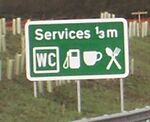
This page provides a non-technical guide to the different types of signs used to advise drivers of an upcoming trunk road service area. There is a similar page for Motorway Signs.
Between 1982 and 2002, A-road signs would be either white-on-green or black-on-white depending on the class of the road. This is now no longer the case, and signs must always be be either white-on-blue (motorway) or black-on-white (A-road). The remaining white-on-green services signs were supposed to be removed by 2015, but many remain.
The rules outlined below apply to service areas that meet the required standards. Due to the variable standard of A-road facilities (and the variable competence of highway employees) there are a lot of situations which don't follow these rules to the letter. Individual exceptions can also be authorised.
Mainline Signs
Motorway Services
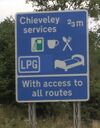
Where a motorway service area is accessed from another road, Diagram 2310.1 should be used on any non-motorway approach, if a sign is needed. This sign is similar to Diagram 2919.1, but it doesn't include a header board or the price of fuel. The sign is the operator's property.
Note that while most service areas that are positioned at a motorway junction are motorway service areas, this isn't automatically the case. Some only qualify for A-road signage, and some don't qualify for anything at all. There is also no rule about how important a side-road has to be before it can get full signs: the B1224 has full signage for Wetherby, for example.
Even though the standard set of motorway signs were changed in 2012 to include more brand logos, this (and in fact all A-road signs) remain unchanged, and continue to use traditional symbols.
This blue sign was introduced in 2002. Before then, large green signs would be used. The new style is similar to the original unofficial A-road services signs.
Approach Sign
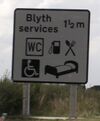
Much like the approach sign on the motorway, Diagram 2313.1 is placed half a mile before a service area, or more if that would interfere with other signs. There are two completely different signs which can be used here:
- Diagram 2313.3 includes a plate saying either 'not 24 hours' or 'fuel only 24 hours'.
- Diagram 2313.5 should be used for services which are open to lorries only (includes the HGV symbol and "lorries only").
- A variant of Diagram 2313.5 should be used for services which ban lorries, with a red bar through the symbol and "lorries only" omitted (this can be seen below).
All of these signs allow for the geographical name of the services to be included but that's not mandatory. The symbols on the sign are varied depending on the facilities, and can include: WC, petrol pump, either a cup or a fork and spoon, LPG, tourist information and a bed. They no longer need to include the disabled symbol.
Other than those mentioned above, there is no default allowance for any additional messages, such as "last services before motorway" or "with access to all routes", although they are common.
These signs are the responsibility of the operator.
Direction Sign
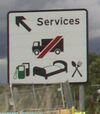
Where the services are at a junction, there is a similar range of signs to be included immediately before the diverge. The signs provide the same information but include an arrow pointing in the correct direction (which is almost always down a slip road). If the previous sign was a Diagram 2313.1 then Diagram 2313.2 should be used here, 2313.4 should come after 2313.3 and 2313.6 should come after 2313.5 - the latter is the example used here.
The bed and lorry symbols must be reversed if the arrow is pointing towards the right.
These signs are also the responsibility of the operator.
Supporting Signage
Exit Sign
For years Diagram 2314.1 was used at the exit into services, which says services with a left-pointing chevron. The problem is that the chevron implies the exit is at or nearly at a right angle, which isn't usually true. Since 2002 Diagram 2314.2 has an arrow pointing to the top-left, like similar signs usually found at a junction.
If the services are at a junction, then the legend 'Services' may be added to the usual exit sign, and to any other direction signs, provided this wouldn't lead to an overload of information. An example of this can be seen under 'continuity signing'. Unlike the motorway equivalent, these signs are the responsibility of the operator.
Continuity Signing
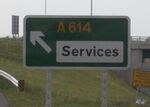
Where services aren't immediately accessible from the road, the legend 'Services' on a white patch should be used to direct traffic to the right place. The example to the right is a cross between this and an exit sign.
The 'Services' legend must always be in black-on-white, unless the service area is classed as a motorway service area, in which case it must be white-on-blue. In both cases, a full name may be used.
Local authorities use this continuity signage as an easy way to describe a petrol station. For example, at Coastways, you have a roundabout with an exit that primarily serves a BP forecourt and a McDonald's drive thru. People on the roundabout need to know which lane they should use for those facilities, but brand names are not permitted on road signs. As a result, "Services" is used to refer to them, even though this isn't a qualifying service area.
Although this can cause confusion, it's not really a problem so long as none of the other signage from this page is used.
Other Signs
Local Facilities
Traders in by-passed communities often ask for signs to direct traffic back onto the old road. They or the local authority can fund a Diagram 2308.1 sign which points to "local facilities" and includes the symbols WC, petrol pump, cup, spoon and fork, bed and tourist information as required. For more specific facilities, Diagram 2328 should be used, which is in white-on-brown tourist colours.
If the direction to these facilities is not obvious, Diagram 2309.1 points to them and includes the distance.
Diagram 2025 looks like a normal junction sign, but has an extra road leaving the destination and rejoining the main carriageway. This can also be used to show a village which is alongside the main road and allows you to easily drive through it.
Truckstops and Lay-bys
Where a truckstop doesn't meet the standards required but it's been decided that it warrants some signing anyway, Diagrams 2502 (one mile ahead), 2505 (final sign) and 2507 (at the entrance) should be used. These all have the parking HGV symbols, and the one mile sign can include toilets and a pay phone. These are all paid for by the operator.
While lay-bys aren't service areas as such, it's worth noting them. These are built and run by England's national highway authority and the 1 mile sign should either consists of Diagram 2501 (the blue P sign) or, for larger services, Diagram 2502, which is black-on-white and can include the symbols for parking, toilets, pay phone, tourist information and HGV spaces. The entrance should have a Diagram 801 sign (the standard parking sign).
Non-Trunk Roads
The rules described here are created by National Highways, who manage trunk roads in England. Other authorities are expected to follow this policy if they want to signpost a service area, but the rules weren't created with local roads in mind and things quickly become messy. A common approach is to use the continuity signing, but nothing else.
A common grey area is what happens when responsibility for a road passes from National Highways to a local authority. The evidence from Redwings (where the A1 became a B-road) and the A45 is that the signs are often left up and appear to be forgotten about.
In cases where a local authority road approaches a National Highways road at a junction which has a full service area, it won't normally have signs, simply because nobody will agree on who should pay for them. If National Highways are changing the junction and paying for new signs anyway, or if the developer is building a new service area and paying for new signs anyway, then signs may be placed on the local road too.
History
Until the introduction of the green sign in 1982, there were no permitted signs for any non-motorway services.
The Department for Transport had started to use standard motorway signs for some A-road services, which attracted criticism from motorway operators who reckoned their reputation was being dragged down by unscrupulous roadside garages.